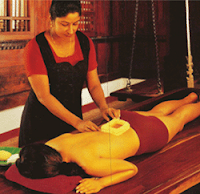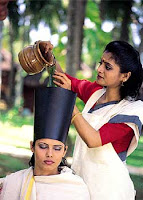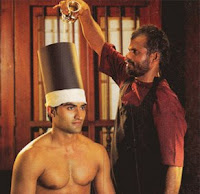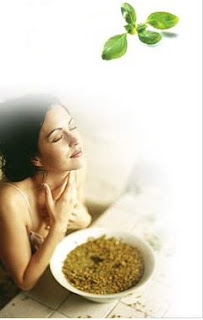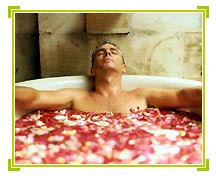Objective Of This Blog
What is Ayurveda ?
History of Ayurveda
8 Disciplines in Ayurveda
Aim of Ayurveda
3 Doshas - Vata, Pitta, Kapha
What is Vata
What is Pitta
What is Kapha
Physical Benefits of Ayurveda
Psychological Benefits of Ayurveda
Kerala, The Land of Ayurveda
Ayurvedic treatment
What is Panchakarma
Different ayurvedic massage therapies
Types of Ayurvedic Treatments
ABHYANGA Massage
SIRO ABHYANGA Massage
PRISTA ABHYANGA Massage
PADA ABHYANGA Massage
KALARI MARMA Massage
UDVARTHANA Massage
SIRODHARA Massage
NAVARAKIZHI
PIZHICHIL
SIROVASTHI
KATIVASTHI
CHOORNASWEDAN
UROVASTHI
NASYAM
About Us
Search All About Ayurveda Here
About Us
|
 We specialise in ayurveda from Kerala and all of our clients are satisfied, and our clientelle list is increasing. To get a better idea of ayurveda, please contact us. We hope your experience with us will be positive and will help broaden your outlook on holistic therapy.
We specialise in ayurveda from Kerala and all of our clients are satisfied, and our clientelle list is increasing. To get a better idea of ayurveda, please contact us. We hope your experience with us will be positive and will help broaden your outlook on holistic therapy.You can find more about us or find out why you should try us by browsing through the links. For further information please write to us on aayurvedaa4u@googlemail.com. Also join us by using the JOIN US section on the top right hand side of our blog. Also please do not forget to write to us.
NASYAM
|
 Medicated oil is administered in to nostrils for treatment of sinusitis, migraine, headaches, paralytic conditions and for cleansing the nasal cavities. Duration is around 20 minutes.
Medicated oil is administered in to nostrils for treatment of sinusitis, migraine, headaches, paralytic conditions and for cleansing the nasal cavities. Duration is around 20 minutes.
SIROVASTHI
|
In this highly specialised Ayurvedic treatment, lukewarm herb-infused Ayurvedic oil is poured in to a cap fitted on the head. Highly recommended for facial paralysis, migraine, sleeping disorders, stress, headaches and other conditions. Duration is around 55 minutes.
PIZHICHIL
|
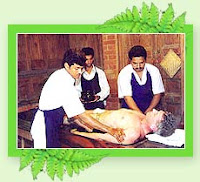 In this highly sought after rejuvenation treatment, lukewarm herb-infused Ayurvedic oil is applied to the body in a special rhythmic way followed by a gentle massage. Pizhichil is highly recommended in conditions such as rheumatic conditions, nervous weaknesses, paralytic conditions, sexual weaknesses, high blood pressure, and promotes general body rejuvenation. Duration is around 55 minutes.
In this highly sought after rejuvenation treatment, lukewarm herb-infused Ayurvedic oil is applied to the body in a special rhythmic way followed by a gentle massage. Pizhichil is highly recommended in conditions such as rheumatic conditions, nervous weaknesses, paralytic conditions, sexual weaknesses, high blood pressure, and promotes general body rejuvenation. Duration is around 55 minutes.NAVARAKIZHI
|
 The whole body is made to perspire by the application of medicinal boluses frequently warmed in herb infused milk. This special Keralite treatment is highly recommended in treating rheumatic conditions, muscular weaknesses, sleeping disorders, high blood pressure and for general body rejuvenation. It makes the body supple, removes stiffness and swellings in the joints. Duration is around 75 minutes.
The whole body is made to perspire by the application of medicinal boluses frequently warmed in herb infused milk. This special Keralite treatment is highly recommended in treating rheumatic conditions, muscular weaknesses, sleeping disorders, high blood pressure and for general body rejuvenation. It makes the body supple, removes stiffness and swellings in the joints. Duration is around 75 minutes. SIRODHARA Massage
|
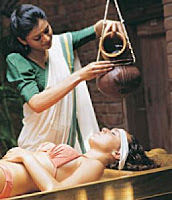 Luke warm herb-infused Ayurvedic oil is gently and steadily poured over the forehead in a continuous stream using a special rhythmic swaying movement, while a gentle massage is given also on the forehead. This results in a fantastic sense of deep relaxation and inner peace; highly effective in removing mental stress and anxieties, in treating insomnia and headaches and improves memory. Massage duration is around 80 minutes.
Luke warm herb-infused Ayurvedic oil is gently and steadily poured over the forehead in a continuous stream using a special rhythmic swaying movement, while a gentle massage is given also on the forehead. This results in a fantastic sense of deep relaxation and inner peace; highly effective in removing mental stress and anxieties, in treating insomnia and headaches and improves memory. Massage duration is around 80 minutes.UDVARTHANA Massage
|
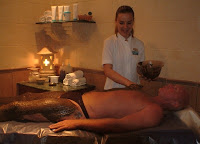 Finely ground Ayurvedic herbs are mixed with precious Ayurvedic oils and gently massaged in to the skin with special massage techniques. This is essentially used as part of a safe weight reduction programme. It also results in: the stimulation of the hair follicles and tissues in order to breakdown the deep-seated fat tissues; detoxification and nourishment of the body tissues; the activation of the skin's natural metabolism; and also the improvement of the lymph flow. The udvarthana massage cleanses and refines the skin structures and gives the skin a soft, silky texture and a lustrous glow. Massage duration is around 55 minutes.
Finely ground Ayurvedic herbs are mixed with precious Ayurvedic oils and gently massaged in to the skin with special massage techniques. This is essentially used as part of a safe weight reduction programme. It also results in: the stimulation of the hair follicles and tissues in order to breakdown the deep-seated fat tissues; detoxification and nourishment of the body tissues; the activation of the skin's natural metabolism; and also the improvement of the lymph flow. The udvarthana massage cleanses and refines the skin structures and gives the skin a soft, silky texture and a lustrous glow. Massage duration is around 55 minutes.KALARI MARMA Massage
|
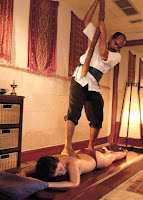 Ayurvedic massage for stimulating vital points Traditional Keralite Ayurvedic massage using herb infused Ayurvedic oils, performed by the therapist using his hand and feet, applying appropriate pressure to specific vital points/parts of the body. Marma abhyanga not only relieves back pain, stiffness and sports injuries but also stimulates various bodily organs and systems. Massage duration is around 70 minutes.
Ayurvedic massage for stimulating vital points Traditional Keralite Ayurvedic massage using herb infused Ayurvedic oils, performed by the therapist using his hand and feet, applying appropriate pressure to specific vital points/parts of the body. Marma abhyanga not only relieves back pain, stiffness and sports injuries but also stimulates various bodily organs and systems. Massage duration is around 70 minutes.PADA ABHYANGA Massage
|
 This highly relaxing Ayurvedic foot massage uses special Ayurvedic oils, revitalises the tired feet and legs as well as the entire body since feet contain key energy points relating to all other parts of the body. It improves blood circulation and helps in treating varicose veins. It also reduces swelling, soreness in the lower leg, prevents dryness, cramps and other conditions. Massage duration is around 30 minutes.
This highly relaxing Ayurvedic foot massage uses special Ayurvedic oils, revitalises the tired feet and legs as well as the entire body since feet contain key energy points relating to all other parts of the body. It improves blood circulation and helps in treating varicose veins. It also reduces swelling, soreness in the lower leg, prevents dryness, cramps and other conditions. Massage duration is around 30 minutes.PRISTA ABHYANGA Massage
|

Special herbs infused Ayurvedic oils are used for this highly relaxing and revitalising massage, which relieves acute and chronic backaches, stiffness, sciatica, and muscle spasms. It also improves blood circulation to the muscles of the back and relieves strain throughout the body. Massage duration is around 35 minutes.
ABHYANGA Massage
|
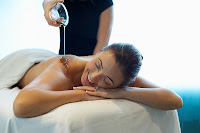 Special herb infused Ayurvedic oils are slowly warmed up and gently massaged in to the skin. The massage is deeply relaxing, harmonises, detoxifies, strengthens and revitalises the entire body. This massage also improves lymph flow and stimulates the immune system.
Special herb infused Ayurvedic oils are slowly warmed up and gently massaged in to the skin. The massage is deeply relaxing, harmonises, detoxifies, strengthens and revitalises the entire body. This massage also improves lymph flow and stimulates the immune system.Furthermore, whilst providing a tired person with a new energy, it simultaneously calms and strengthens the nervous system. It is immediately followed by a steam bath/shower.
Abhyangam can increase the production of white blood corpuscles and antibodies, which provide more resistance against viruses and diseases. This helps the defense mechanism in the body and increases immunity towards environmental changes. In this way abhyangam massage is a
protector, preserver and a rejuvenator, increasing self-confidence and will power. To massage is to exercise the nervous system. Massage duration is around 55 min
Types of Ayurvedic Treatments
|
Shodhana therapy (Purification Treatment)
Shamana therapy (Palliative Treatment)
Pathya Vyavastha (Prescription of diet and activity)
Nidan Parivarjan (Avoidance of disease causing factors)
Satvavajaya(Psychotherapy)
Rasayana therapy(use of immunomodulators and rejuvenation medicines)
The treatments are designed around your individual health needs. They have no side effects at all and there is a wide range of therapies. Information on therapies for the following disorders and more are available:
Back pain, neck pain, whiplash, obesity, joint pain, arthiritis, diabetes, sleeplessness, migraine, stiffness, frozen shoulder, digestive disorders, high blood pressure, pulled muscles, high cholesterol, trapped nerve paralytic conditions, certain skin conditions, stress and strain.
Different ayurvedic massage therapies
|
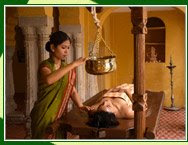 Thus in Ayurveda, abhyangam massage is highly praised and much emphasis is placed on the use of oils in massage. However, you must note the above are only guidelines for abhyangam and you should consult with a qualified ayurvedic physician. In the UK, a qualified physician should have the initials BRCP (British Register of Complementary Practitioners), and must have BAMS (Bachelor of Ayurvedic Medicine and Surgery) or a suitable equivalent. The abhyangam massage itself should be ideally done by the physician or an experienced therapist.
Thus in Ayurveda, abhyangam massage is highly praised and much emphasis is placed on the use of oils in massage. However, you must note the above are only guidelines for abhyangam and you should consult with a qualified ayurvedic physician. In the UK, a qualified physician should have the initials BRCP (British Register of Complementary Practitioners), and must have BAMS (Bachelor of Ayurvedic Medicine and Surgery) or a suitable equivalent. The abhyangam massage itself should be ideally done by the physician or an experienced therapist.1. ABHYANGA ~ Ayurvedic whole body massage.
2. SIRO ABHYANGA ~ Ayurvedic head, neck and shoulder massage.
3. PRISTA ABHYANGA ~ Ayurvedic back massage.
4. PADA ABHYANGA ~ Ayurvedic leg massage
5. KALARI MARMA MASSAGE ~ Ayurvedic massage for stimulating vital points.
6. UDVARTHANA ~ Ayurvedic herbal body-scrub massage.
7. SIRODHARA ~ Ayurvedic forehead oil flow treatment.
8. SIROVASTHI ~ Ayurvedic head soaking
9. KATIVASTHI ~ Lower back bath
10. UROVASTHI ~ Ayurvedic chest bath
11. NAVARAKIZHI
12. PIZHICHIL
13. CHOORNASWEDAN
14. NASYAM
What is Panchakarma
|
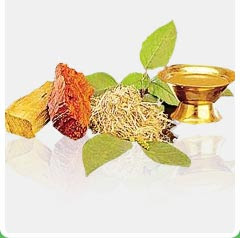 Treatment of the disease consists in avoiding causative factors responsible for disequilibrium of the body matrix through the use of Panchakarma procedures, medicines, suitable diet, activity and regimen for restoring the balance and strengthening the body mechanisms to prevent or minimize future occurrence of the disease. Normally treatment measures involve use of medicines, specific diet and prescribed activity routine.
Treatment of the disease consists in avoiding causative factors responsible for disequilibrium of the body matrix through the use of Panchakarma procedures, medicines, suitable diet, activity and regimen for restoring the balance and strengthening the body mechanisms to prevent or minimize future occurrence of the disease. Normally treatment measures involve use of medicines, specific diet and prescribed activity routine.The following are some of the benefits of Panchakarma:
- Cleanses the whole body of toxins and restores balance.
- Strengthens the immune system, thus improving resistance to illnesses.
- It reverses the effects of stress and ageing in mind and body.
- It enhances our strength, energy and vitality, as well as mental clarity and alertness.
- It helps the body to heal itself, thus reducing dependency on herbs and medicines.
Ayurvedic treatment
|
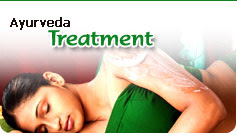 Ayurvedic treatment involves establishing an individual's mind-body constitution and nature of imbalance initially and then seeking to return to a state of healthy balance. The treatment consists of the use of herbal remedies, special Ayurvedic massage therapies, dietary, lifestyle advice and other aspects of treatment, tailor made for that individual.
Ayurvedic treatment involves establishing an individual's mind-body constitution and nature of imbalance initially and then seeking to return to a state of healthy balance. The treatment consists of the use of herbal remedies, special Ayurvedic massage therapies, dietary, lifestyle advice and other aspects of treatment, tailor made for that individual.The time periods for the Ayurvedic treatments are guidelines it might take for a session. The exact time will differ depending on the needs of the client and a good Ayurvedic physician will design the treatment around the client. Generally the treatments are advised for 7 – 14 or 21 days depending upon the chronicity of the ailment. The treatments differ in terms of time, intensity and oils used, in order to meet the client's specific requirements. Panchakarma benefits both the healthy and unhealthy and is considered to be the most effective therapy for preventing and curing disease as well as for revitalizing the entire human organs.
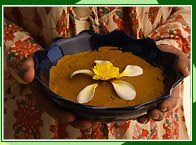 Ayurvedic treatment involves establishing an individual's mind-body constitution and nature of imbalance initially and then seeking to return to a state of healthy balance. The treatment consists of the use of herbal remedies, special Ayurvedic massage therapies, dietary, lifestyle advice and other aspects of treatment, tailor made for that individual.
Ayurvedic treatment involves establishing an individual's mind-body constitution and nature of imbalance initially and then seeking to return to a state of healthy balance. The treatment consists of the use of herbal remedies, special Ayurvedic massage therapies, dietary, lifestyle advice and other aspects of treatment, tailor made for that individual.  The time periods for the Ayurvedic treatments are guidelines it might take for a session. The exact time will differ depending on the needs of the client and a good Ayurvedic physician will design the treatment around the client. Therefore the treatment will defer in terms of time, intensity and oils used, in order to meet the clients specific requirements. Contact your Ayurvedic physician to find out which treatment or combination of treatments suit you.
The time periods for the Ayurvedic treatments are guidelines it might take for a session. The exact time will differ depending on the needs of the client and a good Ayurvedic physician will design the treatment around the client. Therefore the treatment will defer in terms of time, intensity and oils used, in order to meet the clients specific requirements. Contact your Ayurvedic physician to find out which treatment or combination of treatments suit you.Kerala, The Land of Ayurveda
|
 Kerala is one of the southern states of India and has the highest literacy rate in India.
Kerala is one of the southern states of India and has the highest literacy rate in India.Kerala's equable climate, natural abundance of forests (with a wealth of herbs and medicinal plants), and the cool monsoon season (June - November) are best suited for Ayurveda's curative and restorative packages.
In fact, today, Kerala is the state in India which promotes research and practices ayurveda the most. Traditional texts reveal that the monsoon in Kerala is the best season for rejuvenation programmes. The atmosphere remains dust-free and cool, opening the pores of the body to the maximum, making it most receptive to herbal oils and therapy.

Kerala Ayurveda has developed in a remarkable way to compete with the modern world. The Ayurvedic physicians are awarded the basic degree BAMS (Bachelor in Ayurvedic Medicine & Surgery) which is a five and half years of residential study programme in the medical universities. One who has completed this bachelor programme has to register under the Indian medical council for practicing. Post Graduate (MD) education is conducted in the medical universities as a further three-year residential study in different specialities.

Psychological Benefits of Ayurveda
|
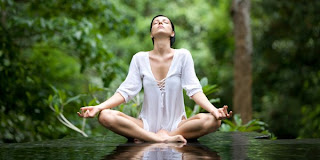 Perhaps ayurveda is the first such medical systems who recognizes that all diseases are but the direct manifestation of one's mental conditions. It says human mind consists three states or trigunas — sattva, rajas and tamas. Any disturbances in the equilibrium of the tri-gunas, manifest in physical illness according to the intensity or nature of the disturbances. In fact, the condition of body and mind are integral to the overall health of an individual.
Perhaps ayurveda is the first such medical systems who recognizes that all diseases are but the direct manifestation of one's mental conditions. It says human mind consists three states or trigunas — sattva, rajas and tamas. Any disturbances in the equilibrium of the tri-gunas, manifest in physical illness according to the intensity or nature of the disturbances. In fact, the condition of body and mind are integral to the overall health of an individual. When the mind is stressed the stress hormone cortisone is released by adrenal glands. The level of hormone released affects the total volume of the brain's hippocampus, which regulates our memory. Stress also affects all our decision-making activities in every field of life. Ayurveda stresses on four principles—regulation in ahara (food habit), vihara (activities), nidra (sleeping habit), and maithuna (sexual habit), to maintain the balance and equanimity of the mind. Especially its guidelines for an intelligently regulated diet and daily routine are, now, accepted techniques for stress management.
When the mind is stressed the stress hormone cortisone is released by adrenal glands. The level of hormone released affects the total volume of the brain's hippocampus, which regulates our memory. Stress also affects all our decision-making activities in every field of life. Ayurveda stresses on four principles—regulation in ahara (food habit), vihara (activities), nidra (sleeping habit), and maithuna (sexual habit), to maintain the balance and equanimity of the mind. Especially its guidelines for an intelligently regulated diet and daily routine are, now, accepted techniques for stress management. Ayurvedic massages, inhalation of herbal (Aromatherapy) preparations, panchakarma (nasya) besides the much-tested yogasanas and meditation leave a calming effect on the nerves.
Ayurvedic massages, inhalation of herbal (Aromatherapy) preparations, panchakarma (nasya) besides the much-tested yogasanas and meditation leave a calming effect on the nerves. According to ayurveda, tamasic (inertia, short of judgment) and rajasic (excessive activities, short of judgment) tendencies of mind prompt an individual to indulge in criminal or violent activities, telling lies and other such misconduct. This gives rise to negative thoughts like fear, anxieties, insecure feeling, greed, jealousy and anger.
Physical Benefits of Ayurveda
|
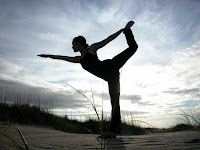
 Non – invasive diagnostic ayurvedic treatments are beneficial for chronic patients suffering from diseases such as diabetes, heart ailments and cancer.
Non – invasive diagnostic ayurvedic treatments are beneficial for chronic patients suffering from diseases such as diabetes, heart ailments and cancer.Ayurvedic medicine resorts to outward diagnosis of symptoms by studying a patients' habits—diet and daily life, pulse, tongue, nail, face, lip, eye, nature of perspiration etc. Difficult diseases like asthma and tumor growths (gulmas) are managed effectively by these diagnostic methods.
Detoxification methods of ayurveda like Panchakarma and other herbal health remedies, when applied wholly or singly, make the body more responsive to medicines and treatment. It hastens the healing process.
Various yoga asanas prescribed by ayurveda help prevent the diseases from occuring and accumulating. Yogasanas achieve the twin purpose of strengthening body-parts such as bones, muscle and vital organs like heart, liver, stomach, intestine as well as keeping our blood circulation and psychological conditions strong and resilient.Most importantly, a discerning diet according to one's dosha type, and well-regulated life (dinacharya) helps strengthen one's natural immune system.
What is Kapha
|
Kapha is the watery humour. "Kapha cements the elements in the body, providing the material for physical structure. This dosha maintains body resistance. Kapha lubricates the joints; provides moisture to the skin; helps to heal wounds; fills the spaces in the body; gives biological strength, vigor and stability; supports memory retention; gives energy to the heart and lungs and maintains immunity...Kapha is responsible for emotions of attachment, greed and long-standing envy; it is also expressed in tendencies toward calmness, forgiveness and love." Too much Kapha leads to lethargy and weight gain, as well as congestion and allergies.
What is Pitta
|
Pitta is said to be composed of fire and water; it governs "all heat, metabolism and transformation in the mind and body. It controls how we digest food, how we metabolize our sensory perceptions, and how we discriminate between right and wrong." Pitta must be kept in balance, too. "Too much Pitta can lead to anger, criticism, ulcers, rashes and thinning hair.". A balanced Pitta mind makes one a good leader with a warm personality.
What is Vata
|
Vata, composed of air, governs all movement in the mind and body and must be kept in good balance. Too much vata leads to "worries, insomnia, cramps and constipation. Vata controls blood flow, elimination of wastes, breathing and the movement of thoughts across the mind." Vata activates the nervous system, hearing and speech; and expresses as enthusiasm and creativity. Vata also controls the other two principles, Pitta and Kapha, and is usually the first cause of disease. Another word for Vata is Vayu - it is the more traditional Sanskrit word for air.
3 Doshas - Vata, Pitta, Kapha
|
 In ayurveda there are 3 main doshas (medical humours), which are Vata (resembles the classical element air), Pitta (fire), and Kapha (water).All bodily processes are believed to be governed by a balance of the 3 doshas. Whichever dosha appears to dominate a person's behavior and physique is called his constitution type. Each constitution type has particular strengths and susceptibilities.Often a person is a dual dosha (e.g. Vata/Pitta) or even Tridosha (all three doshas).
In ayurveda there are 3 main doshas (medical humours), which are Vata (resembles the classical element air), Pitta (fire), and Kapha (water).All bodily processes are believed to be governed by a balance of the 3 doshas. Whichever dosha appears to dominate a person's behavior and physique is called his constitution type. Each constitution type has particular strengths and susceptibilities.Often a person is a dual dosha (e.g. Vata/Pitta) or even Tridosha (all three doshas).Aim of Ayurveda
|
 The main aim is to maintain positive health of a healthy & to help a patient with various treatments to overcome the disease Ayurveda tells you the means to be healthy, stay healthy &live a longer happier, successful life.
The main aim is to maintain positive health of a healthy & to help a patient with various treatments to overcome the disease Ayurveda tells you the means to be healthy, stay healthy &live a longer happier, successful life.It deals with each & every aspect of our life. It offers complete life style guidance based on the individual's personal needs. Ayurveda says you should go with nature & you can maintain the positive health,teaches you the ART OF LIVING.
Ayurveda is basically: HEALTH PROMOTIVE, PREVENTIVE, CURATIVE AND NUTRITIVE (All self contained)
8 Disciplines in Ayurveda
|
 A perusal of its several classical treatises indicate presence of two schools of Physicians and Surgeons and eight specialities. These eight disciplines are generally called "Ashtanga Ayurveda" and are :-
A perusal of its several classical treatises indicate presence of two schools of Physicians and Surgeons and eight specialities. These eight disciplines are generally called "Ashtanga Ayurveda" and are :-• Internal Medicine(Kaya Chikitsa)
• Paediatrics(Kaumar Bhritya)
• Psychiatry( Bhoot Vidya)
• Otorhinolaryngology and Ophthalmology(Shalakya)
• Surgery( Shalya)
• Toxicology( Agad Tantra)
• Geriatrics(Rasayana)
• Eugenics and aphrodisiacs(Vajikarana)
History of Ayurveda
|
 Ayurveda originated in the 10th century BC, but its current form took shape between the 5 th century BC and the 5th century AD. Ayurvedic philosophy is attached to sacred texts, the Vedas, and based on the theory of Panchmahabhutas - all objects and living bodies are composed of the five basic elements: earth, water, fire, air, and sky. Similarly, there is a fundamental harmony between the environment and individuals, which is perceived as a macrocosm and microcosm relationship. As such, acting on one influences the other. Ayurveda is not only a system of medicine, but also a way of living. It is used to both prevent and cure diseases. Ayurvedic medicine includes herbal medicines and medicinal baths. It is widely practised in South Asia, especially in Bangladesh, India, Nepal, Pakistan, and Sri Lanka.
Ayurveda originated in the 10th century BC, but its current form took shape between the 5 th century BC and the 5th century AD. Ayurvedic philosophy is attached to sacred texts, the Vedas, and based on the theory of Panchmahabhutas - all objects and living bodies are composed of the five basic elements: earth, water, fire, air, and sky. Similarly, there is a fundamental harmony between the environment and individuals, which is perceived as a macrocosm and microcosm relationship. As such, acting on one influences the other. Ayurveda is not only a system of medicine, but also a way of living. It is used to both prevent and cure diseases. Ayurvedic medicine includes herbal medicines and medicinal baths. It is widely practised in South Asia, especially in Bangladesh, India, Nepal, Pakistan, and Sri Lanka.Ayurvedic medicine is said to have originated from the ancient Hindu sacred texts the Vedas, but these actually contain few medical references. Modern scholars believe it evolved, gradually absorbing influences from Buddhism and other traditions along the way.
The basis of Ayurveda is contained in two great medical compendiums written by Charaka and Sushruta more than 2,000 years ago. These texts cover a vast array of topics including pathology, diagnosis, treatment, surgery, lifestyle advice and philosophy. Legend has it that Charaka's compendium contains teachings passed down from the Hindu god Indra. Copies of these texts, written in Sanskrit on palm leaves, survive today and form the basis of Ayurvedic training.
What is Ayurveda ?
|
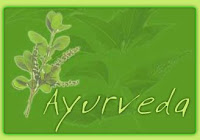 Ayurveda or ayurvedic medicine is a more than 2,000 year old and originated in India. It is a comprehensive system of medicine based on a holistic approach rooted in Indian Vedic culture. The word ayurveda means knowledge (veda) of life (ayur) or ‘Science of Life’. It deals elaborately with measures for healthful living during the entire span of life and its various phases.
Ayurveda or ayurvedic medicine is a more than 2,000 year old and originated in India. It is a comprehensive system of medicine based on a holistic approach rooted in Indian Vedic culture. The word ayurveda means knowledge (veda) of life (ayur) or ‘Science of Life’. It deals elaborately with measures for healthful living during the entire span of life and its various phases.Besides, dealing with principles for maintenance of health, it has also developed a wide range of therapeutic measures to combat illness. These principles of positive health and therapeutic measures relate to physical, mental, social and spiritual welfare of human beings. Thus Ayurveda becomes one of the oldest systems of health care dealing with both the preventive and curative aspects of life in a most comprehensive way and presents a close similarity to the WHO’s concept of health propounded in the modern era.
Ayurveda is form of "alternative therapy". It is a tried and tested form of traditional medicine. Ayurveda was a health care system that had been supporting many cultures and large civilisations.
There are now several universities and institutions that specialise in qualifications in ayurveda all around the world, such as in India, UK and USA (Try searching ayurvedic universities in the search box above).
There are recognised ayurvedic degrees and qualifications such as Bachelor of Ayurvedic Medicine and Surgery, and registers such as the British Register of Complementary Practitioners.
In summary, Ayurveda represents a system that considers both the states of mind and body in its diagnosis and treatment. Ayurveda took into consideration the fact that many illnesses are caused by foreign agents and small organisms that may require intervention. Patients are classified by body types, or prakriti, which are determined by proportions of the Three doshas. Illness and disease are considered to be a matter of imbalance in the doshas. Treatment is aimed at restoring harmony or balance to the mind-body system.
Objective Of This Blog
|
 This blog is created to spread the awareness about Ayurveda - the Indian medical treatment and its benefits. We try to provide helpfull information on Ayurvedic therapy and treatment which is now gaining reputation as one of USA, UK's and Europes most effective treatments.
This blog is created to spread the awareness about Ayurveda - the Indian medical treatment and its benefits. We try to provide helpfull information on Ayurvedic therapy and treatment which is now gaining reputation as one of USA, UK's and Europes most effective treatments.Our purpose is to provide authentic information and contacts on ayurvedic treatments, that are practiced in Kerala, to clients in the USA, UK, Europe and all over the world.
On further request we do provide contacts of treatment centres across all over the world. We also sell Ayurvedic products which can change your way of life.
Subscribe to:
Posts (Atom)


